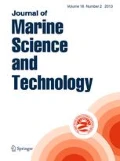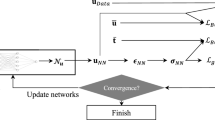Abstract
Based on polynomial interpolation and approximation theory, a novel feed-forward neural network, the feed-forward neural network with Chebyshev orthogonal basis function, is proposed for black-box modeling of ship manoeuvring motion. The neural model adopts a three-layer structure, in which the hidden layer neurons are activated by a group of Chebyshev orthogonal polynomial activation functions and the other two layers’ neurons use identity mapping as activation functions. Weight update formulas are derived by employing the standard back-propagation (BP) training method. With the simulated 15º/15º zigzag test data as input and calculated values of the hydrodynamic forces and moment as output, the feed-forward neural network with Chebyshev orthogonal basis function and the BP neural network are applied to identify the nonlinear functions in the nonlinear hydrodynamic model of ship manoeuvring motion. With the simulated 20º/20º zigzag test data and 35º turning test data as input, the hydrodynamic forces and moment are predicted by using the identified nonlinear functions. Comparison between the calculated and predicted hydrodynamic forces and moment shows that the feed-forward neural network with Chebyshev orthogonal basis function is superior to the BP neural network in identifying the nonlinear functions of the nonlinear hydrodynamic model of ship manoeuvring motion and is an effective method to conduct the black-box modeling of ship manoeuvring motion.





Similar content being viewed by others
References
Hess D, Faller W (2000) Simulation of ship manoeuvres using recursive neural networks. In: 23rd Symposium on Naval Hydrodynamics. Val de Reuil, France, September 2000
Hess D, Faller W (2002) Using recursive neural networks for blind predictions of submarine manoeuvres, In: 24th Symposium on Naval Hydrodynamics. Fukuoka, Japan, July 2002
Hess D, Faller W, Lee J et al (2006) Ship maneuvering simulation in wind and waves: a nonlinear time-domain approach using recursive neural networks. In: 26th Symposium on Naval Hydrodynamics. Rome, Italy, September 2006
Hess D, Faller W, Lee J (2008) Real-time nonlinear simulation of maneuvers for US navy combatant DTMB 5415. In: Workshop on verification and validation of ship manoeuvring simulation methods, SIMMAN 2008, vol 1, E15-E21, Copenhagen, Denmark, April 2008
Hess D, Faller W, Minnick L et al (2007) Maneuvering simulation of Sea Fighter using a fast nonlinear time domain technique. In: Ninth international conference on numerical ship hydrodynamics,Ann Arbor, Michigan, USA, August 2007
Ebada A, Abdel-Maksoud M (2005) Applying artificial intelligence (A.I.) to predict the limits of ship turning manoeuvres, Jahrbuch der Schiffbautechnischen Gesellschaft, 99 Band:132–139
Fan SM, Zhu WM, Li ZC (1999) Prediction method for ship maneuverability based on artificial neural networks (in Chinese). Shipbuild China 4:7–12
Rumelhart DE, McClelland JL, PDP Research Group (1986) Parallel Distributed Processing, vol 1, Foundations[M]. MIT Press, Cambridge
Chislett MS, Strǿm-Tejsen J (1965) Planar motion mechanism tests and full-scale steering and maneuvering predictions for a Mariner Class Vessel, Technical Report Hy-6. Hydro- and Aerodynamics Laboratory, Lyngby
Mathews JH, Fink KD (2004) Numerical methods using MATLAB. Pearson Education Inc., Beijing
Abkowitz MA (1964) Lectures on ship hydrodynamics - steering and manoeuvrability, Hydro- and Aerodynamics Laboratory, Report No. Hy-5, Lyngby, Denmark
Ogawa A, Kasai H (1978) On the mathematical model of manoeuvring motion of ship. Int Shipbuild Prog 25(292):306–319
Nomoto K, Taguchi T, Honda K, Hirano S (1957) On the steering qualities of ships. Int Shipbuild Prog 4(35):354–370
Fossen TI (1994) Guidance and Control of Ocean Vehicles. John Wiley, Chichester
Cong S (1998) Neural Network Theory and Applications with MATLAB Tool boxes (in Chinese). Press of University of Science and Technology of China, Hefei
Acknowledgments
Supported by the National Natural Science Foundation of China (Grant Nos. 50979060, 51079031) and the Foundation of National Science and Technology Key Laboratory of Hydrodynamics (Grant No. 9140C2201091001).
Author information
Authors and Affiliations
Corresponding author
About this article
Cite this article
Zhang, XG., Zou, ZJ. Black-box modeling of ship manoeuvring motion based on feed-forward neural network with Chebyshev orthogonal basis function. J Mar Sci Technol 18, 42–49 (2013). https://doi.org/10.1007/s00773-012-0190-1
Received:
Accepted:
Published:
Issue Date:
DOI: https://doi.org/10.1007/s00773-012-0190-1




